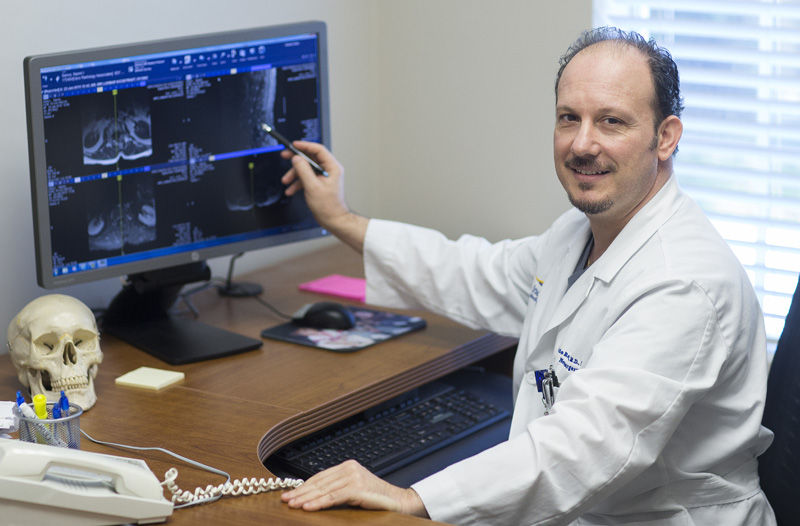About 70 to 80 percent of the U.S. adult population suffers from some form of low back pain according to the National Institute of Neurological Disorders and Strokes. That’s roughly 194 million Americans. The Mayo Clinic says low back pain is one of the top three reasons people go to see a doctor.
One of those doctors is Dr. Fabio Roberti, medical director of neurosurgery at Indian River Medical Center and a department chair and professor at the prestigious George Washington University Hospital in Washington, D.C.
Roberti first gained national notice when the Washington Post turned to him for medical expertise in explaining the malignant brain tumor that claimed the life of the late Senator Edward Kennedy back in 2009. Since coming to Vero Beach in 2011, Roberti says 70 percent or more of his time is spent treating patients with back pain. He says he tends to take a “conservative” approach whenever possible. “Most of the time,” explains Roberti, “patients benefit from non-surgical management including physical therapy, injections, pain management and activity modification. We try to do all those things before even considering surgery.”
The extremely personable Roberti, whose Italian accent never left him, even has a sort of motto for his patients: “Back pain should not hold you back,” he says.
Seeing a neurosurgeon for back pain might seem like an odd choice at first glance, but on further review it makes a great deal of sense. After all, the spinal cord begins at the base of the brain where messages from our body’s pain receptors are processed. Moreover, while the spinal cord itself stops near the lumbar region (the lower back) multiple “nerve roots” do extend from there and, as it happens, those nerve roots are susceptible to a wide variety of problems.
Roberti says that while problems in the spine or lumbar region are usually the root cause of low back pain, there are a large number of other conditions and illnesses that can cause or contribute to the condition.
For example, mechanical problems in the spinal column could be at fault as could scoliosis, spondylolisthesis, arthritis, osteoarthritis, spinal stenosis, dysfunction of the sacroiliac joint, kidney stones, endometriosis, fibromyalgia and infections. Injuries such as those caused by car accidents, falls or sports injuries can also trigger back pain and, whether we like to admit it or not, the natural process of aging can definitely be the cause of low back pain.
According to Roberti, here in Vero Beach by far the most common cause of low back pain is age related. He says he sees more patients with osteoarthritis of the spine than any other condition.
Osteoarthritis of the spine is essentially the breakdown of the cartilage of the joints and discs in the neck and lower back. Sometimes it even produces spurs that can jab or put pressure on the nerve roots leaving the spinal column.
The five lumbar or lower back vertebrae, located between the ribs and the pelvis, are cushioned by a series of small discs surrounded with a jelly-like substance that acts like a shock absorber when we are young. However, with age, those discs wear down and that jelly-like material disappears. That one-two punch can cause nerve endings to signal severe pain messages to the brain.
The good news for low back pain sufferers is that the American Association of Neurological Surgeons says, “Although low back pain can be quite debilitating and painful, in about 90 percent of all cases that pain can improve without surgery.”
When surgery is determined to be the best course of action to put an end to low back pain, Roberti, like so many of his colleagues, is a huge proponent of “minimally invasive” surgery. He credits new technologies. “During the past 10 years in the field of surgery – especially when it comes to the spine – we can now do things we never could have done before.”
In fact, when it comes to surgical procedures, Roberti says, “90 percent of my practice is minimally invasive.” He cites the faster recovery time, the minimal loss of blood and significantly less trauma to the back and the rest of the body as key reasons why he opts for a minimally invasive approach whenever he can.
Neurosurgeons like Roberti diagnose and treat the entire nervous system and yes, that does also include brain surgery. The most common reason for brain surgery, says Roberti, is cancer of the brain and once again he points to advances in technology and credits the IRMC board for bringing the most up-to-date equipment to this small Florida city. He is particularly effusive about the hospital’s linear accelerator. A linear accelerator is a device used in external beam radiation treatments for patients with cancer and it can deliver high-energy x-rays to a patient’s brain tumor minimizing the need to actually cut into the brain tissue.
Still, Roberti and other neurosurgeons see far and away more patients suffering from low back pain than any other condition and their specialized training and education may make them the best bet to ease your aching back.
Dr. Fabio Roberti is at 1040 37th Place, Suite 201 in Vero Beach: 772-563-4741.

